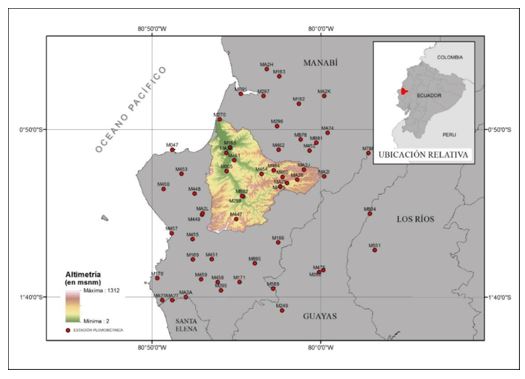Evaluation of palm tree species for the conservation and effective restoration of the ecosystem in the Portoviejo canton, Manabí
Main Article Content
Abstract
The present research called evaluation of palm tree species for the conservation and effective restoration of the ecosystem in the Portoviejo canton, Manabí, aimed to evaluate the palm tree species for the effective conservation and restoration of the ecosystem in said canton. The methods used were theoretical, empirical and statistical - descriptive, which favored the evaluation of palm species. An inventory of 11 types of palm trees belonging to 50 green areas of the canton was obtained. With this inventory, the analysis of the conservation and effective restoration of the ecosystem in the Portoviejo canton was carried out, using Excel software for the construction and analysis of the database. data and for the classification of scenarios the Weka software. Fundamental scenarios were found regarding the maximum expected number of palm trees resistant to a rainy environment, where fungi proliferate and therefore the ecosystem is unbalanced. Likewise, the maximum number of days waiting for positive diagnoses of fungi that affect the environment were taken into account. palm trees and the maximum number of cases of fungus in palm trees diagnosed in one day, after these evaluations a heuristic search was carried out to optimize the evaluation of the case study species, which is useful to support the decision of decisions based on achieving adequate conservation and restoration of the ecosystem in the Portoviejo canton, Manabí.
Article Details

This work is licensed under a Creative Commons Attribution-NonCommercial 4.0 International License.
References
Alistair G. (2007). Sutcliffe y Andreas Gregoriades. Automating Scenario Analysis of Human and System Reliability, IEEE transactions on systems, man, and cybernetics-part A: systems and humans, 37(2): 249-261.
Catagua-Durán & Cabrera-Verdezoto (2023). Parcelas permanentes de monitoreo para la conservación de Bursera graveolens (Kunth) en las comunas Joa y Agua Blanca, Manabi. MQRInvestigar 7(1), 1757-1776. https://doi.org/10.56048/MQR20225.7.1.2023.1757-1776
Chowell G, Luo GR, Sun K, Roosa K, Tariq A, Viboud C. (2019). Real-time forecasting of epidemic trajectories using computational dynamic ensembles. Epidemics. 30:100379. https://doi.org/10.1016/j.epidem.2019.100379. [Epub ahead of print]
Chowell G. (2017). Fitting dynamic models to epidemic outbreaks with quantified uncertainty: A primer for parameter uncertainty, identifiability, and forecasts, Infectious Disease Modelling, https://doi.org/10.1016/j.idm.2017.08.001.
Guoping Zhang, Huanji Pang, Yifei Xue, Yu Zhou, Ruliang Wang(2020). Forecasting and Analysis of Time Variation of Parameters of COVID-19 Infection in China Using An Improved SEIR Model. Public meteorological service center of China Meteorological Administration. 2020. https://www.researchsquare.com/article/rs-16159/v1
Hayden C. Metsky, CA Freije, TSF Kosoko-Thoroddsen, PC Sabeti, C Myhrvold. (2020). CRISPR-based COVID-19 surveillance using a genomically-comprehensive machine learning desing. BioRxiv preprint doi: https://doi.org/10.1101/2020.02.26.967026
Hilgert, N., Pochettino, M. & Hernández Bermejo, E., 2020. PALMERAS NUS AL SUR DE LA AMÉRICA AUSTRAL. 1ª de. Madrid. Programa Iberoamericano de Ciencia y Tecnología para el Desarrollo.
IPCC (2007). Fourth Assessment Report (AR4). Intergovernmental Panel on Climate Change. Disponible en: URL: http://ipcc-wg1.ucar.edu/index.html.
Kennedy J, Eberhart RC. (1995). Particle swarm optimization. In IEEE International Conference on Neural Networks, pp. 1942-1948.
Kosow H, Gaßner R. (2008). Methods of future and scenario analysis. Overview, assessment, and selection criteria. DIE Research Project “Development Policy: Questions for the Future”, p. 133. Studies/Deutsches Institut für Entwicklungspolitik. ISSN 1860-0468. p. 133.
Krueger, R.R., 2021. Biología y utilización de la palmera datilera (Phoenix dactylifera L.). En: El genoma de la palmera datilera, vol. 1: Filogenia, Biodiversidad y Cartografía (3-28). Cham: Springer International Publishing.
León et al (editores). 2011. Libro Rojo de las Plantas Endémicas del Ecuador. Segunda edición. Publicaciones del Herbario QCA. Pontificia Universidad Católica del Ecuador. ISBN: 978-9942-03-393-2.
Malik Magdon-Ismail. (2003). Machine Learning the Phenomenology of COVID-19 From Early Infection Dynamics. arXiv: 2003.07602v2
Montúfar, R, Louise, C, Tranbarger, T (2018). Elaeis oleífera: A neglected palm from the Ecuadorian Amazonia. Rev. Ecuat. de Med. y Cienc. Biol. 39,11-18,
Muhammad A, Jetter, A, Daim, T. (2011). Development of fuzzy cognitive map (FCM)-based scenarios for wind energy. International Journal of Energy Sector Management. 5(4), 564-584, 1750-6220. 2011. DOI 10.1108/17506221111186378.
Rivera, D., Obón, C., Alcaraz, F., Carreño, E., Laguna, E., Amoros, A., Johnson, D., Díaz, G. & Morte, A.,2015. Date Palm Status and Perspective in Spain. En: Al-Khayri, J.M. et al. (Eds.). Recursos genéticos y utilización de la palma datilera, Springer, Dordrecht.
Sares-Reyes, J. G. (2024). Eficiencia del uso de feromona sintética y cebos vegetales en la captura del rhynchophorus palmarum l. en el cultivo de dátil (phoenix dactylifera). Trabajo de titulación previo a la obtención del título de Ingeniero Agropecuario. Universidad Católica de Santiago de Guayaquil. Facultad de Educación Técnica para el Desarrollo, Carrera de Ingeniería Agropecuaria.
Sorousha M. y Parisa A. Bahri. (2009). Hybrid intelligent scenario generator for business strategic planning by using ANFIS. Expert Systems with Applications, 36:7729-7737.
Tian-Mu Chen, Rui, J., Wang, QP, Zhao, ZY, Cui, Jin-An, Ying, Ling. (2020). A mathematical model for simulating the phase-based transmissibility of a novel coronavirus. Infectious Diseases of Poverty, 9 (01), 18-25. https://doi.org/10.1186/s40249-020-00640-3
Trenel P, Gustafsson H, Baker W, Asmussen C, Dransfield J, Borchsenius F. 2007. Mid-Tertiary dispersal, not Gondwanan vicariance explains distribution patterns in the wax palm subfamily (Ceroxyloideae: Arecaceae). Molecular Phylogenetics ande volution 45(1): 272-288.
Viboud C, Simonsen L, Chowell G. (2016). A generalized-growth model to characterize the early ascending phase of infectious disease outbreaks. Epidemics, 15: 27-37.
Vives, S.G., 1999. Plagas y enfermedades de la palmera datilera (Phoenix dactylifera L.) en España. Phytoma España: La revista profesional de sanidad vegetal, 114: 188-191.
Wu JT, Leung K, Leung GM. (2020). Nowcasting and forecasting the potential domestic and international spread of the 2019-nCoV outbreak originating in Wuhan, China: a modelling study. TheLancet. January 31, 2020. https://doi.org/10.1016/S0140-6736(20)30260-9
Zhao, Y., Williams, R., Prakash, C.S. & He, G., 2012. Identification and characterization of gene-based SSR markers in date palm (Phoenix dactylifera L.). BMC plant biology, 12(1): 1-8.
Zixin Hu, Qiyang Ge, Shudi Li, Li Jin, Momiao Xiong. (2020b). Artificial Intelligence Forecasting of COVID-19 in China. 2020. arXiv preprint arXiv:2002.07112.

